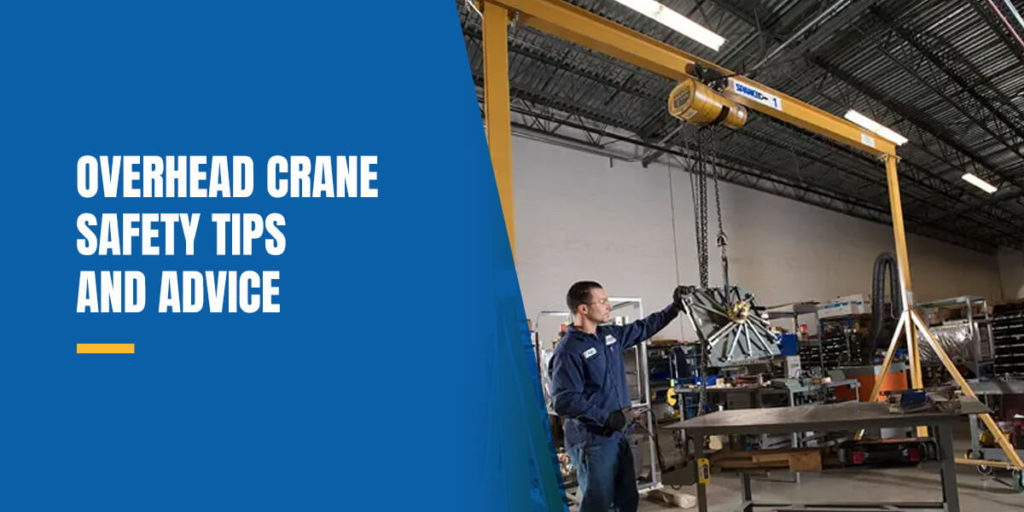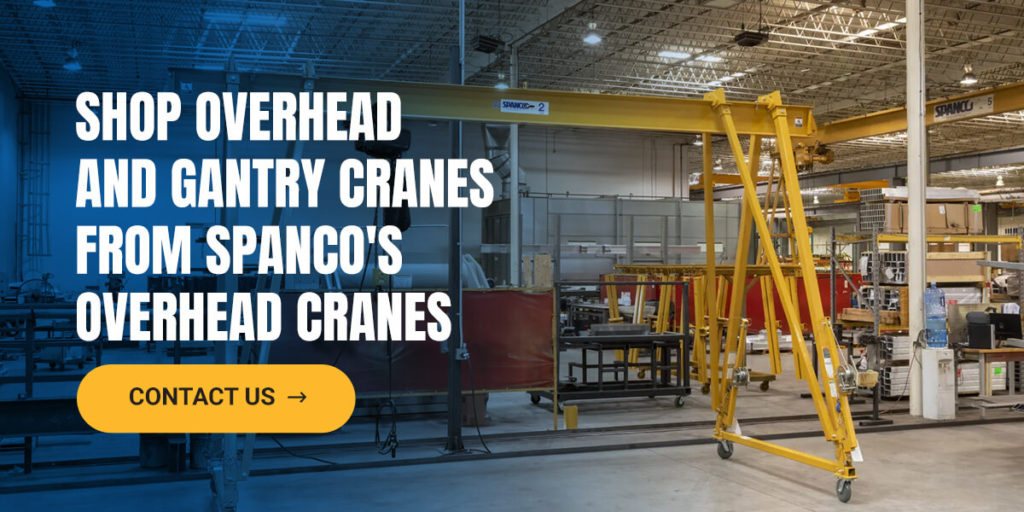
Overhead Crane Safety Tips and Advice
Dic 16, 2022
Overhead cranes are powerful pieces of equipment that offer heavy-lifting capabilities in numerous applications and industries. Operating heavy machinery requires significant training, safety knowledge, and responsibility to help prevent various accidents and incidents in the workplace. Equipment accidents can be dangerous and costly, potentially resulting in serious injuries and downtime.
Keep these tips in mind when operating and working around overhead cranes to ensure the machines are operated properly and protect the safety of workers.
Functions and Operations of an Overhead Crane
An overhead crane is commonly found in industrial work environments. Overhead cranes take many forms. Some are installed in the ceiling and feature a traveling bridge between two parallel beams, like a bridge crane. Others, like industrial gantry cranes, are free-standing, supporting a beam with two legs and swivel casters. Every type of overhead crane is designed for specific uses depending on the application.
Overhead cranes are used to lift, move and position heavy loads, often in assembly lines or facilities to move a load from one area to another. You may use overhead cranes to haul various items, including machinery, hardware, and bulk materials. Overhead cranes utilize electric wire ropes or chain hoists that can be lowered, attached, and raised. The loads are attached with hoisting connections like electromagnets, hooks, and slings.
The crane operator is responsible for the function of the crane. This individual oversees load hookups and uses the crane’s controls to move the load. The operator must know overhead crane safety requirements to ensure the machine is used properly and safely.
General Safety Requirement Checklist
Regardless of the type of overhead crane in use, crane operators and other workers in the area need to follow general safety guidelines. Overhead cranes present unique risks and hazards, requiring proper safety knowledge to ensure workers stay safe during crane operations. Here are several general safety tips to keep in mind when working with or around overhead cranes.
1. Be Aware of Your Surroundings
One of the biggest safety tips surrounding overhead cranes is being aware of your surroundings. Since the crane operator is responsible for the suspended load, their awareness is critical. Watch where you’re moving the load to ensure other people or things don’t get in the way while the load is moving. This is especially important to prevent workers from getting under the suspended load, which should always be avoided to prevent crush injuries if the load falls.
Additionally, the operator should watch for obstacles that could cause a collision when moving a load. For example, if machinery is left unattended or other workers pass through the area, there’s an increased potential for a collision. The area should be kept clear when the crane is in operation to reduce the risk of these hazards.
Other employees in the surrounding area should be aware of crane operations, as well. Ensure everyone working around a crane knows where they should be when it’s in operation and how to keep themselves and others safe.
2. Lift Loads Within the Crane’s Limits
Overhead crane manufacturers typically set a recommended weight limit, so crane operators know what the crane is capable of safely lifting. These weight limits are in place to ensure the crane is used as intended.

Only lift loads that are within a crane’s weight limit. Doing so helps prevent damage to the load, crane, and worker safety. When purchasing a crane, be sure to consider the maximum weight of your loads so you can find a crane that meets that capacity.
3. Perform Preventive Maintenance
Like any other heavy equipment, overhead cranes require preventive maintenance to stay in good condition. Preventive maintenance involves caring for the machine consistently to help prevent serious issues from occurring. For example, preventive maintenance allows you to catch small issues like replacing a filter or changing the oil before they create significant issues that require costly repairs or replacements.
Keeping up with preventive maintenance helps ensure your team is using equipment in optimal condition, which is much safer than using equipment that has been neglected.
4. Only Operate Cranes With Proper Training
Because overhead cranes are considered heavy equipment, operators must be adequately trained to use the crane. To legally operate certain types of cranes, operators need certifications or licenses. Certification requirements can vary from state to state and employer to employer. Regardless of whether a certification is needed, an overhead crane operator should be trained to safely use the machine to reduce potential risks.
5. Inspect the Crane Daily
The Occupational Safety and Health Administration (OSHA) requires daily crane inspections. At the start of each shift, the operator is expected to visually inspect the crane before use. OSHA daily crane inspection requirements include checking all operating mechanisms for damage and ensuring the parts operate as they should.
Operators should check the following crane parts in their daily inspections:
- Air and hydraulic systems
- Hoisting connections
- Electrical apparatus
- Ground conditions
- Safety devices
Gantry Crane Safety
Because gantry cranes are a bit different than some overhead cranes, they have some different safety specifications. Since these cranes are free-standing, the gantry crane installation process is much simpler than some overhead cranes. However, if you’re building the gantry yourself, you must ensure it’s straight and sits on level ground. If one leg is longer than the other or sits at a different angle, the crane’s lift capacity will be affected and may create hazardous conditions.
Additionally, be sure to exercise extreme caution with the legs on wheels. While swivel casters are convenient, they can roll before you’re ready. Use breaks or stop blocks to prevent the crane from moving while you’re attaching or detaching a load from the crane. When rolling the gantry crane, there is a risk of the load swinging while you move the crane. A swinging load puts unnecessary stress on your crane and can cause significant damage or injury if it hits something.
Be sure to consider any risks and safety needs associated with gantry cranes to ensure everyone’s safety.

Shop Overhead and Gantry Cranes From Spanco’s Overhead Cranes
Overhead cranes need to be high-quality and durable to adequately support your loads. At Spanco’s, we design our cranes with components built to last. From corrosion-resistant paint and plating to precision welding and tolerances, our pre-engineered cranes are among the best available. Our certified engineers can even tailor cranes to meet your specific needs.
Browse our selection of gantry cranes and other types of overhead cranes, or contact our team for more information.
Categories
Share this post
Contact us
Looking for the perfect fall protection equipment? Let us help!